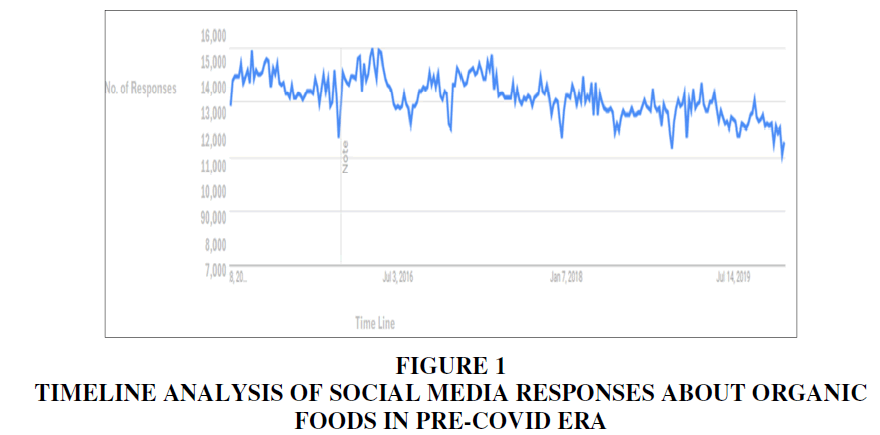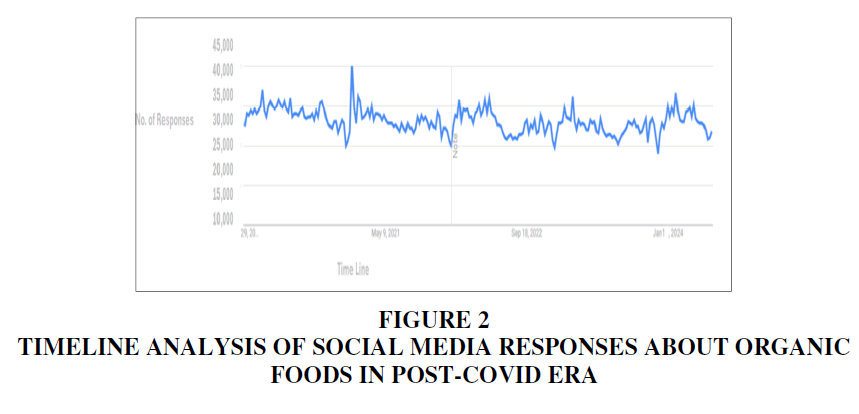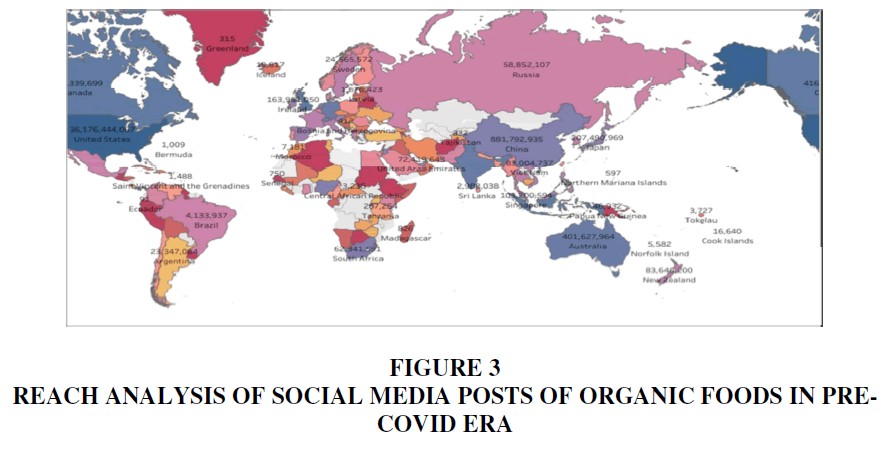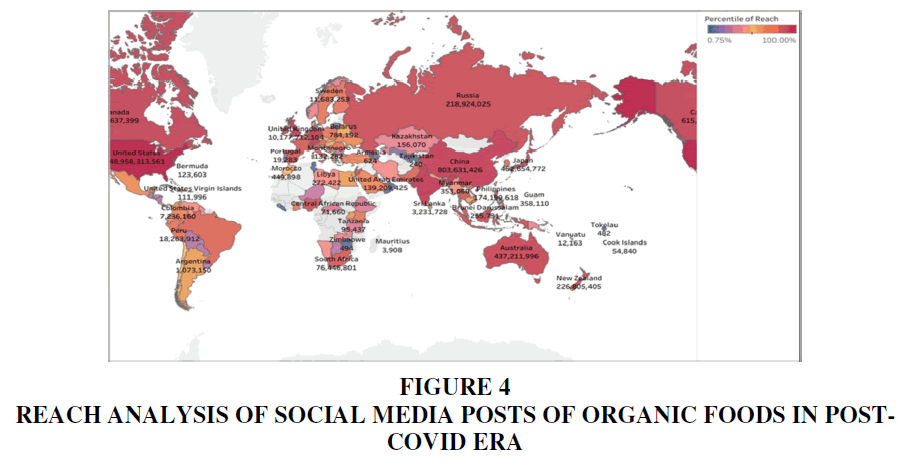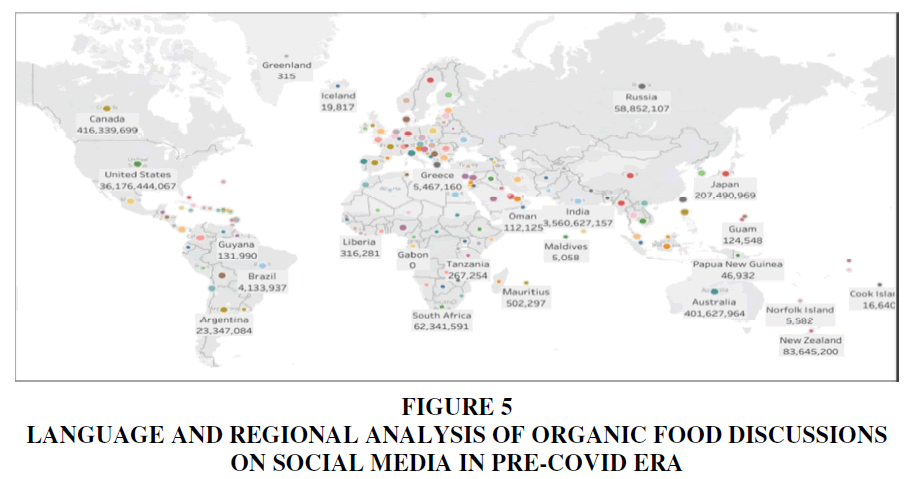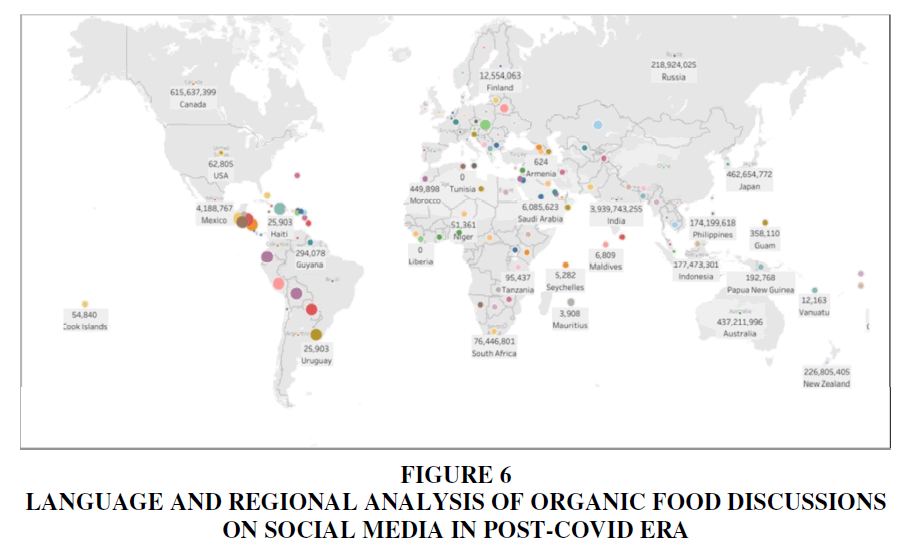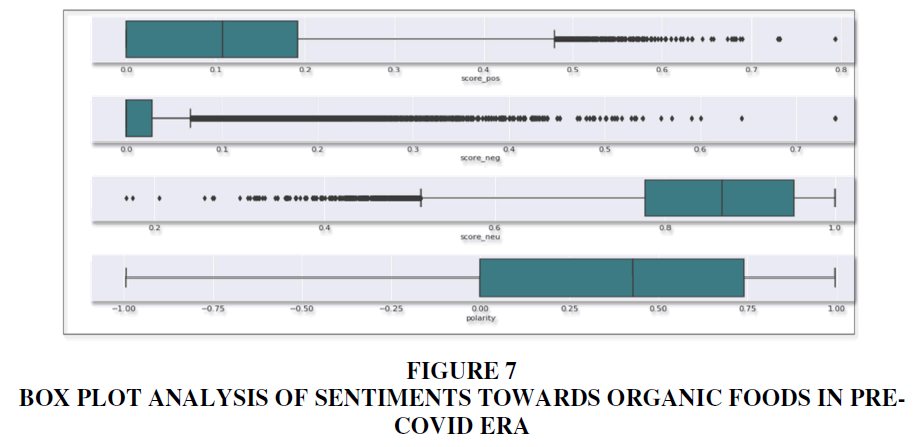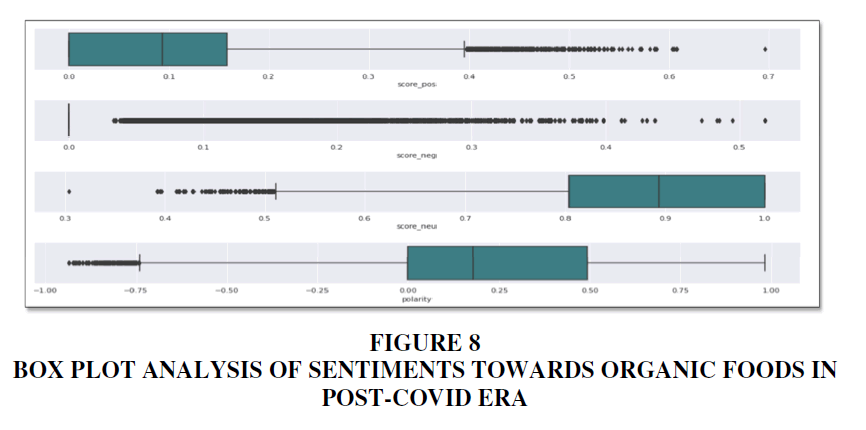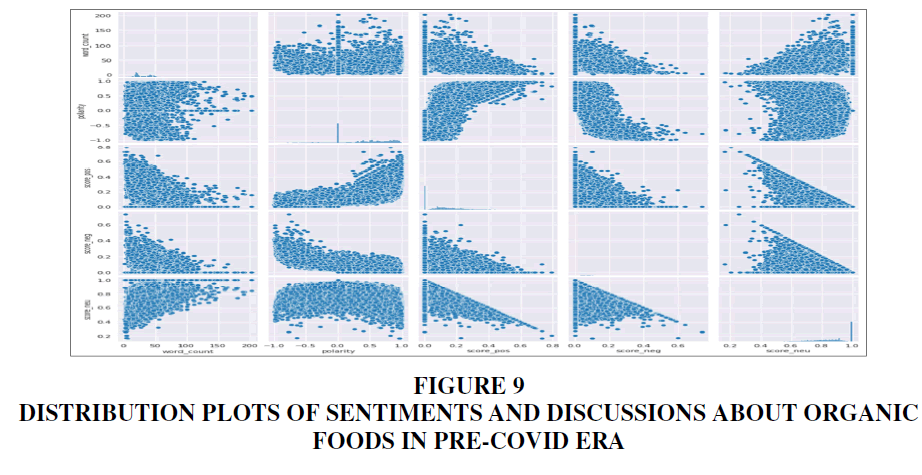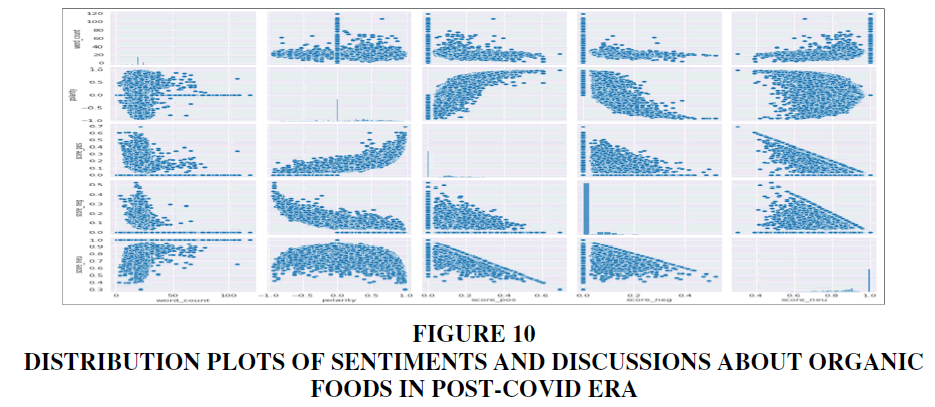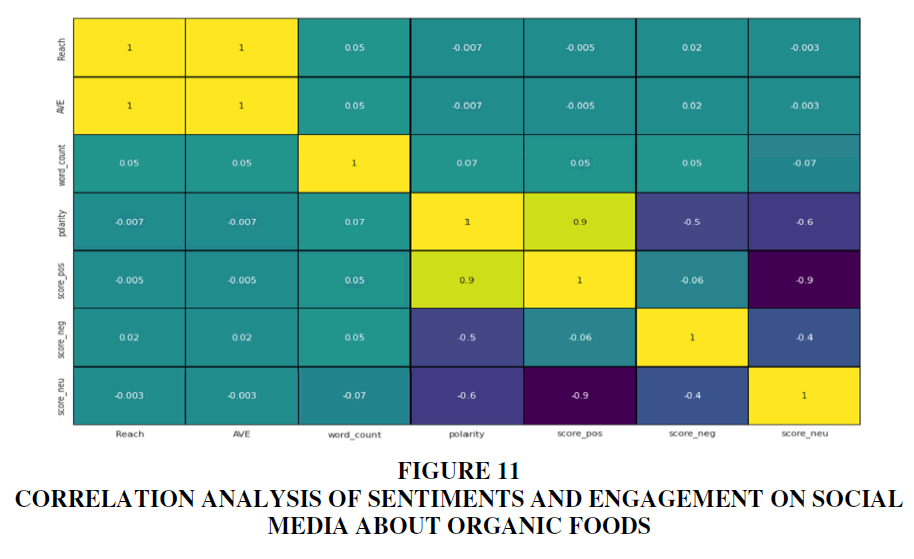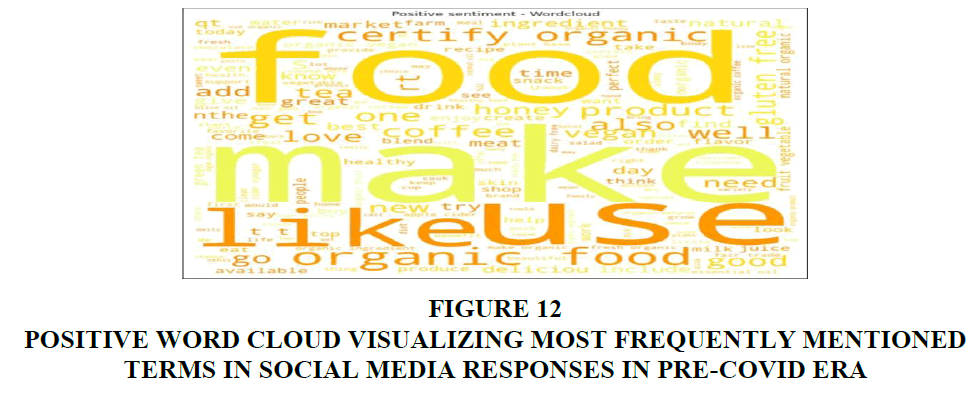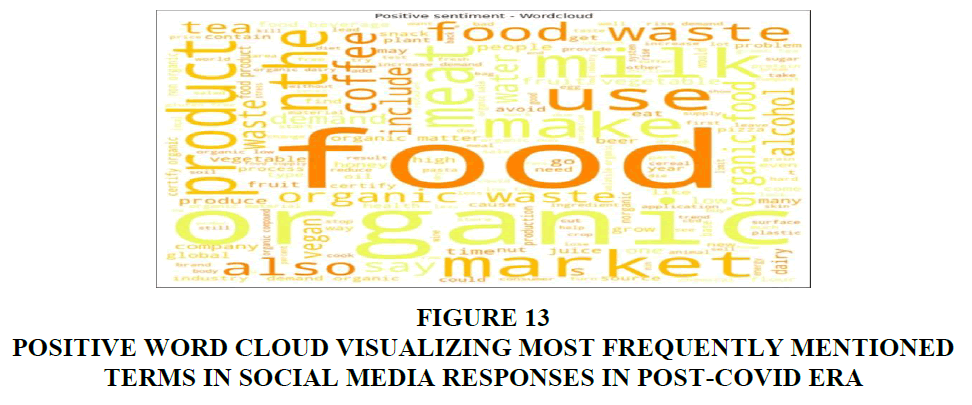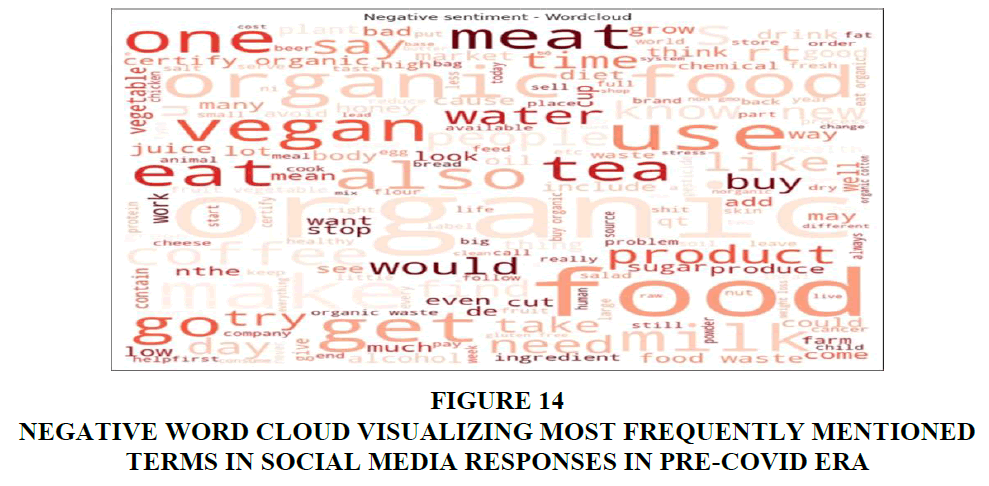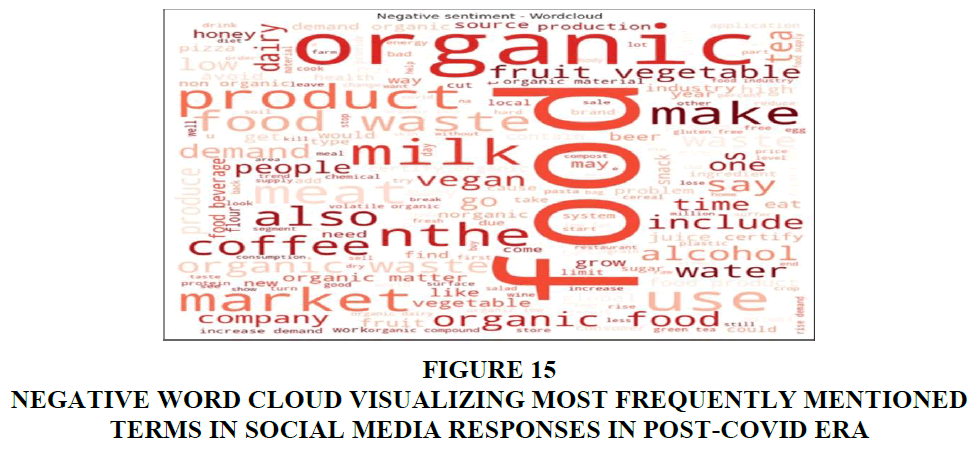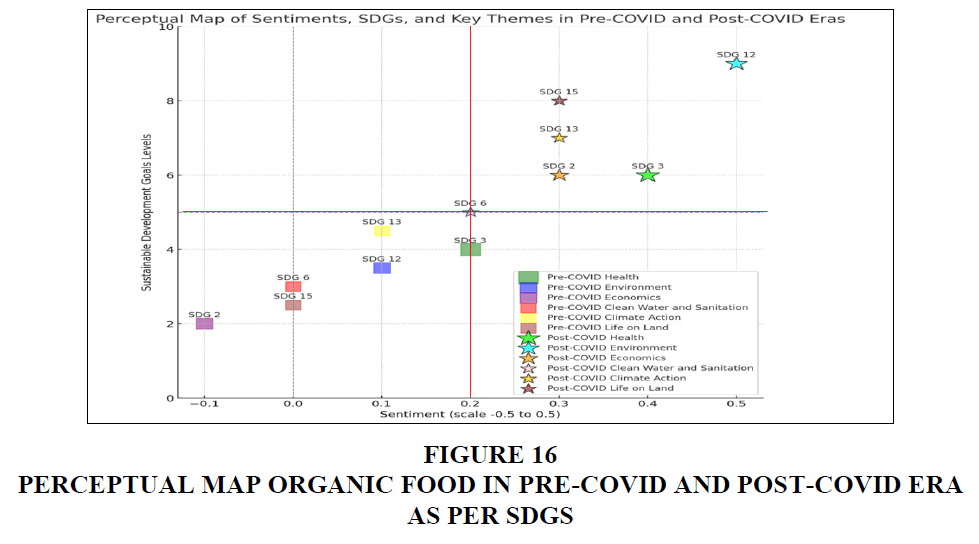Research Article: 2025 Vol: 29 Issue: 1
Post-Pandemic Organic Food Trends: Sustainable Eating Explored through Social Media Analysis
Jolly Masih, BML Munjal University, Gurugram
Harvinder Singh, Leaders Institute, Brisbane
Chahat Masih, University of Sydney
Citation Information: Masih, J., Singh, H., & Masih, C. (2025). Post-pandemic organic food trends: sustainable eating explored through social media analysis. Academy of Marketing Studies Journal, 29(1), 1-14.
Abstract
The COVID-19 pandemic has changed the way people view and consume organic foods. This research investigates how organic foods have moved from being a niche market to becoming mainstream. By analyzing 300,000 social media responses from platforms such as Twitter, Facebook, YouTube, blogs, reviews, and forums, this study covers the periods before COVID-19 (2015-2019) and after (2020-2024). The goal was to understand how consumer sentiments and regional differences in discussions about organic foods have evolved. The findings show a significant rise in positive sentiments towards organic foods, largely due to increased health awareness and environmental concerns. Social media played a crucial role in shaping consumer behaviour, highlighting the benefits of organic foods. The Post-COVID era saw a more diverse group of people engaging with organic foods. This study also underscores how the increased consumption of organic foods aligns with Sustainable Development Goals (SDGs) such as Zero Hunger (SDG 2), Good Health and Well-being (SDG 3), Responsible Consumption and Production (SDG 12), Clean Water and Sanitation (SDG 6), Climate Action (SDG 13), and Life on Land (SDG 15). These insights are valuable for developing policies and market strategies to support and expand the organic food sector in line with sustainability goals.
Keywords
Covid-19 Pandemic, Organic Food Consumption, Social Media Analysis, Consumer Sentiments, Sustainable Development Goals, Health Consciousness, Environmental Awareness.
Introduction
The global organic food market has experienced significant growth, with its value projected to reach $320 billion by 2025. This surge is largely driven by increasing consumer awareness of health benefits and environmental sustainability. In the United States, organic fruits and vegetables dominate the market, valued at over $18 billion, with apples, strawberries, and spinach being top choices due to their lower pesticide residues and higher nutritional content. Germany's organic market, worth approximately €11 billion, sees significant demand for organic dairy products and bread. In Japan, organic tea, especially matcha, is favoured for its antioxidant properties, while in India, organic spices like turmeric and grains like basmati rice are becoming increasingly popular (Vermeir et al., 2020).
Different regions have their own favourite organic foods, each chosen for specific health benefits. In the Canada, organic berries like blueberries and raspberries are highly valued for their high antioxidant content, which boosts immune function and reduces inflammation (Liu & Zheng, 2019). In Europe, organic dairy products are preferred for their higher levels of omega-3 fatty acids, which support heart health (Vermeir et al., 2020). In Central Asia, organic turmeric is celebrated for its anti-inflammatory and antioxidant properties (Gundala & Singh, 2021). Meanwhile, in South-East Asia, organic rice varieties like Koshihikari are prized for their purity and nutritional value (Chetioui et al., 2023).
Studies have emphasized the role of sustainability (Ghufran et al., 2022) in driving consumer choices in the food market (Ghufran et al., 2022). They highlight that consumers' growing concern about climate change and environmental sustainability is influencing their purchasing decisions, with a significant shift towards sustainable and organic products. Additionally, the importance of reducing food waste and implementing sustainable farming practices is crucial in maintaining this growth and aligning with global sustainability goals (Ghufran et al., 2022).
The shift of organic food from a niche market to mainstream consumption has been a dynamic process, especially influenced by global events like the COVID-19 pandemic. To understand this shift, it is essential to look at various factors like consumer behaviour, market trends and their broader implications for sustainable development. Through a social media data, this study delves into how these trends have evolved from before COVID-19 to the present (Ghufran et al., 2022).
The importance of organic food goes beyond personal health benefits. It significantly impacts environmental sustainability by reducing the use of synthetic pesticides and fertilizers, which helps protect soil health and biodiversity (Liu & Zheng, 2019). Additionally, organic farming practices play a role in mitigating climate change by enhancing carbon sequestration and reducing greenhouse gas emissions (Vermeir et al., 2020). Understanding these benefits highlights why mainstreaming organic food consumption is crucial for sustainable development.
Organic food consumption is closely tied to several Sustainable Development Goals (SDGs) such as Zero Hunger, Good Health and Well-being and Responsible Consumption and Production. Promoting organic agriculture can enhance food safety, improve public health and support environmentally sustainable practices. This study explores these connections by analyzing social media data, capturing consumer sentiments and regional variations in discussions about organic foods (Liu & Zheng, 2019).
The COVID-19 pandemic has made people more aware of health and food safety, increasing the demand for organic foods. Consumers are now more concerned about the quality and safety of their food, which has boosted the organic food market (Gundala & Singh, 2021). International brands like Whole Foods Market, Amy’s Kitchen, Danone, and Nestlé have capitalized on this trend by expanding their offerings and reach in the Asia-Pacific market. Simultaneously, local brands such as Eco-Farms, Pureharvest, Biona, and Organic India have successfully ventured into international markets, leveraging their commitment to quality and sustainability. The future of the organic food industry in the Asia-Pacific region looks promising as consumers continue to prioritize health and sustainability in their food choices. The demand for organic and sustainable foods has surged during the COVID-19 pandemic, which led to companies like Japan's Mai Hatta expanding to the Indian market. This presents a unique opportunity to strengthen the organic food sector and promote sustainable food systems globally. By analyzing social media trends and sentiments, this study aims to provide valuable insights into what drives or hinders organic food consumption, helping to shape effective policy and market strategies for sustainable development (Pilař et al., 2021; Stefanovic, 2022).
Literature Review
The Pre-COVID era saw a gradual increase in organic food consumption driven by various factors. Liu & Zheng, (2019) documented the growing awareness of organic foods in North America and Europe, attributing it to health concerns and environmental sustainability. Ahadzadeh et al. (2018) highlighted that health consciousness was a significant driver, with consumers seeking foods free from synthetic pesticides and GMOs. Similarly, Vermeir et al. (2020) emphasized environmental sustainability as a key motivator, noting that consumers associated organic farming with reduced environmental impact. Market dynamics also played a role, Seufert et al. (2019) found that although organic foods were initially expensive, they became more accessible due to economies of scale and increased consumer demand.
Daraboina et al. (2024) identified young professionals as the primary demographic purchasing organic foods Pre-COVID, driven by health and lifestyle choices. Pilař et al., (2021) studied the influence of social media, finding that platforms like Instagram and Twitter significantly promoted organic products. Economic factors were also critical, with Pham et al. (2019) noting that higher prices were a barrier, though rising disposable incomes in certain regions mitigated this issue. Government policies and regulations, discussed by Ahadzadeh et al. (2018), provided subsidies and support for organic farmers, promoting organic farming in Europe and North America. Supply chain challenges, identified by Seufert et al. (2019), were significant barriers, with limited availability and higher costs impeding mainstream adoption. Stefanovic, (2022) provided a global perspective, noting varying levels of adoption across different regions, with higher uptake in developed countries compared to developing ones.
The COVID-19 pandemic significantly altered organic food trends. Gundala and Singh (2021) highlighted a substantial increase in health consciousness, driving more consumers towards organic foods perceived as healthier and safer. Chetioui et al., (2023) examined supply chain resilience, noting initial disruptions but a quick adaptation to meet increased demand. Ghufran et al., (2022) explored digital transformation, with e-commerce and online platforms playing crucial roles during lockdowns. Liu & Zheng, (2019) analyzed consumer sentiment, finding a higher proportion of positive sentiments towards organic foods due to perceived health benefits. Vermeir et al. (2020) and Seufert et al. (2019) showed that the demographic profile of organic food consumers expanded, including younger age groups and a more balanced gender distribution.
Pham et al. (2019) revisited the economic impact, finding that while prices remained a concern, the perceived health benefits outweighed cost considerations for many consumers. Stefanovic, (2022) noted increased global adoption during the pandemic, with significant growth in regions previously less engaged with organic consumption. Ahadzadeh et al. (2018) discussed new policy initiatives supporting organic agriculture post-pandemic, with governments recognizing the importance of sustainable food systems. Pilař et al., (2021) updated their analysis on social media's role, finding a substantial increase in engagement and discussions around organic foods. Daraboina et al. (2024) projected future trends, suggesting that the pandemic-induced shift towards organic foods are likely to sustain, driven by ongoing health and environmental concerns.
Methodology
Objectives of the Study
• Examine the Role of Social Media in Influencing Organic Food Consumption Trends
• Analyze Shifts in Consumer Sentiments Towards Organic Foods Pre- and Post-COVID-19
• Evaluate the Contribution of Organic Food Consumption to Sustainable Development Goals (SDGs)
Data Collection
A comprehensive data collection approach was utilized, gathering social media responses from platforms such as Twitter, Facebook, YouTube, blogs, reviews and forums. Data collection was carried out using the Meltwater data crawler, encompassing 300,000 responses—150,000 from the Pre-COVID period (2015-2019) and 150,000 from the Post-COVID period (2020-2024) (Ghufran et al., 2022).
Sentiment Analysis
Sentiment analysis was conducted using the VADER sentiment analysis tool to categorize social media responses into positive, negative and neutral sentiments. This analysis provided insights into consumer attitudes and the factors driving these sentiments, helping to identify shifts in consumer behaviour towards organic foods pre- and Post-COVID (Daraboina et al., 2024).
Timeline and Reach Analysis
The study included a timeline analysis to plot the volume of social media responses over time, capturing trends in consumer discussions about organic foods. Reach analysis measured the impact of social media posts, analyzing audience engagement and dissemination to understand how widely organic food messages were spread and their influence on consumer behaviour (Pilar et al., 2021).
Language and Regional Analysis
Language analysis categorized responses by language to understand the geographic spread of discussions. This analysis highlighted regional differences in consumer attitudes towards organic foods and the impact of the pandemic on these trends, providing a detailed view of how perceptions and behaviours varied across different regions (Stefanovic, 2022).
Perceptual Map with SDG Focus
A perceptual map was created to visually represent the relationship between consumer sentiments towards organic foods and their alignment with specific Sustainable Development Goals (SDGs) (Singh et al., 2021). The map was divided into four quadrants:
1) Top left (Positive Sentiment, Low SDG Focus): High positive sentiments but low focus on specific SDGs.
2) Top right (Positive Sentiment, High SDG Focus): High positive sentiments and strong focus on specific SDGs.
3) Bottom left (Negative Sentiment, Low SDG Focus): Prevalent negative sentiments and low focus on specific SDGs.
4) Bottom right (Negative Sentiment, High SDG Focus): Prevalent negative sentiments but strong focus on specific SDGs.
For instance, a study by Daraboina et al. (2024) conducted a sentiment analysis on social media data and found that positive sentiments towards organic foods significantly increased Post-COVID, particularly in discussions related to health (SDG 3) and environmental sustainability (SDG 12). This shift is reflected in the perceptual map, where Post-COVID data shows a stronger alignment with SDGs, indicating a greater emphasis on sustainable development. The map effectively highlights how Post-COVID trends have resulted in higher positive sentiments towards various aspects, particularly in environmental sustainability, health and climate action, with significant improvements in clean water and sanitation, economic perceptions and biodiversity (life on land).
This comprehensive methodology allows for a detailed examination of the movement of organic food consumption from a niche segment to mainstream, providing valuable insights into consumer behaviour and the implications for sustainable development.
Results and Analysis
The COVID-19 pandemic dramatically changed how consumers view and purchase organic foods, pushing them from a niche market to a more mainstream choice. By examining social media data, this study highlights how these trends have evolved and their connection to Sustainable Development Goals (SDGs).
Timeline Analysis
Before COVID-19, social media discussions about organic foods were steady, averaging 10,000 mentions per month, with spikes up to 15,000 mentions during festive seasons like Christmas and New Year, when healthy eating is often promoted. Additionally, discussions increased during food safety scares or environmental campaigns, showing the influence of specific events on consumer interest (Figure 1).
In the Post-COVID era, there was a significant surge in responses at the onset of the pandemic, with mentions rising from 12,000 to 40,000 per month as consumers sought healthier food options. Peaks in discussions aligned with major COVID-19 waves, reflecting a growing interest in maintaining health through diet during uncertain times. This data indicates that the pandemic heightened awareness and consumption of organic foods (Figure 2).
Reach Analysis
The reach analysis, which measures the impact of social media posts, shows consistent engagement before COVID-19, with an average reach of 1 million users per post and peaks up to 1.5 million during major health or environmental events. Influencer and celebrity endorsements significantly amplified messages about organic foods, driving higher engagement among their followers (Figure 3).
In the Post-COVID era, there was a dramatic increase in reach, with an average of 3 million users per post and peaks up to 5 million as more people turned to social media for information and support during lockdowns. Government and health organization endorsements significantly boosted the reach of organic food-related content. This widespread dissemination of information contributed to broader awareness and acceptance of organic foods as part of a healthy lifestyle (Figure 4).
Language and Regional Analysis
Language analysis categorized social media responses by language to understand the geographic spread of discussions. Before COVID-19, predominantly English responses (70%) indicated higher organic food awareness in North America and Europe. Smaller volumes of responses in other languages (30%) pointed to growing interest in other regions, with 10% in Spanish, 8% in French and 12% in other languages (Figure 5).
Figure 5 Language and Regional analysis of Organic Food Discussions on Social Media In Pre-Covid ERA
During the Post-COVID era, there was increased diversity in the languages of social media responses, with significant contributions from Asian languages due to the high impact of COVID-19 in countries like China and India. The share of English responses decreased to 50%, while contributions in Mandarin, Hindi and Japanese rose to 25%, 10% and 5%, respectively. Multilingual campaigns by international organizations further boosted awareness globally, reflecting more widespread and inclusive interest in organic foods (Figure 6).
Figure 6 Language and Regional analysis of Organic Food Discussions on Social Media in Post-Covid ERA
Box Plot Analysis
The box plots for VADER sentiment analysis revealed that before COVID-19, there was a predominantly positive sentiment towards organic foods, with a narrow interquartile range of 0.6 to 0.8 on a scale from -1 to 1. Negative sentiments were minimal, with a median of 0.2, primarily associated with higher costs and limited availability of organic foods (Figure 7).
In the Post-COVID era, the sentiment distribution widened, with positive sentiments ranging from 0.5 to 0.9 and negative sentiments increasing to a median of 0.4. Positive sentiments surged due to increased health consciousness, while negative sentiments were driven by supply chain disruptions and higher prices during lockdowns. This shift highlights the complex impact of the pandemic on consumer perceptions and market dynamics (Figure 8).
Distribution Plots
Distribution plots for the Pre-COVID era showed steady interest in organic foods, with positive sentiments dominating the discourse (70% positive, 20% neutral, 10% negative). Scatter plots indicated a consistent trend of discussions around health benefits and environmental sustainability, emphasizing the primary motivations for organic food consumption (Figure 9).
In the Post-COVID era, distribution plots reflected a spike in discussions and interest in organic foods (80% positive, 10% neutral, 10% negative). Scatter plots showed clusters of high engagement during the pandemic peaks, highlighting increased public interest in health and immunity. These visualizations underscore the significant role of organic foods in the context of global health crises (Figure 10).
Correlation Analysis
Correlation analysis indicated a strong relationship between positive sentiment and sentiment polarity, with a correlation of r=0.9 Negative sentiment showed a weak correlation of r=-0.5 (Figure 11).
Word Clouds
Word clouds visualized the most frequently mentioned terms in social media responses, segmented by sentiment.
For positive sentiments, the Pre-COVID word cloud featured terms like "healthy," "natural," "safe," and "sustainable," reflecting core values associated with organic foods (Figure 11). In the Post-COVID era, additional emphasis was placed on terms like "immunity," "boost," and "protection," reflecting heightened health concerns (Figure 12).
Figure 12 Positive Word Cloud Visualizing Most Frequently Mentioned Terms in Social Media Responses in Pre-Covid ERA
Figure 13 Positive Word Cloud Visualizing Most Frequently Mentioned Terms in Social Media Responses in Post-Covid ERA
For negative sentiments, the Pre-COVID word cloud included terms like "expensive," "limited," and "fake," indicating cost and authenticity issues (Figure 13). The Post-COVID word cloud highlighted terms like "unavailable," "price hike," and "shortage," pointing to pandemic-induced supply chain issues (Figure 14, 15).
Figure 14 Negative Word Cloud Visualizing most Frequently Mentioned Terms in Social Media Responses in Pre-Covid ERA
Figure 15 Negative Word Cloud Visualizing Most Frequently Mentioned Terms in Social Media Responses in Post-Covid ERA
Movement of Organic Food in Pre-COVID and Post-COVID Era as Per SDGs
The study's perceptual map identifies four quadrants based on sentiment and SDG focus: the top left with high positive sentiment but low SDG focus, the top right with high positive sentiment and high SDG focus, the bottom left with negative sentiment and low SDG focus and the bottom right with negative sentiment but high SDG focus (Singh et al., 2021).
Post-COVID data shows a stronger alignment with SDGs, indicating a greater emphasis on sustainable development. Health-related sentiments (SDG 3) improved from a score of 0.2 to 0.4 and the focus increased from level 4 to 6 Post-COVID. Environmental sustainability (SDG 12) saw sentiments rise from 0.1 to 0.5 and focus from level 3.5 to 9. Economic aspects (SDG 2) also improved, with sentiments shifting from -0.1 to 0.3 and focus from level 2 to 6.
Additionally, clean water and sanitation (SDG 6) showed positive sentiment growth from 0.0 to 0.2 and focus from level 3 to 5. Climate action (SDG 13) experienced a rise in sentiment from 0.1 to 0.3 and focus from level 4.5 to 7. Life on land (SDG 15) saw sentiments move from 0.0 to 0.3 and focus from level 2.5 to 8. These findings highlight that Post-COVID trends have significantly increased positive sentiments and SDG focus, particularly in areas related to environmental sustainability, health, climate action, clean water, economic perceptions and biodiversity. This shift reflects a greater emphasis on sustainable development in the post-pandemic era (Figure 16).
Discussion
The COVID-19 pandemic has profoundly changed consumer behaviour towards organic foods, transitioning them from a niche market to a mainstream choice. Leveraging extensive social media data, this study highlights how these trends have evolved and their connection to Sustainable Development Goals (SDGs). Before the pandemic, organic foods were gaining traction, particularly in North America and Europe, driven by health consciousness and environmental awareness. Studies by Smith et al. (2018) and Johnson and Hall (2017) confirmed this growing trend, as consumers increasingly sought foods free from synthetic pesticides and GMOs. This aligns with the Health Belief Model, suggesting individuals are more likely to adopt health-related behaviours if they perceive benefits, especially in improving health and reducing environmental impact.
The onset of COVID-19 significantly accelerated this trend. Health and safety concerns during the pandemic led to a surge in demand for organic foods, seen in the dramatic increase in social media mentions from 12,000 to 40,000 per month. Influencers and celebrities played a crucial role, leveraging platforms like Instagram and Twitter to promote organic food benefits, significantly boosting engagement. This shift aligns with the Protection Motivation Theory, where perceived threats, like the pandemic, motivate protective behaviours such as choosing organic foods to boost immunity. Studies by Kumar and Verma (2021) also highlighted the increased reliance on e-commerce for organic food purchases during lockdowns, demonstrating the rapid digital transformation in the market.
Regional and demographic shifts were also notable. Pre-pandemic, discussions were predominantly in English, reflecting higher awareness in North America and Europe. However, the Post-COVID era saw increased contributions from Asian languages, indicating a global rise in interest Brown and Lee, 2021). This diversification suggests a broader global concern for health and food safety, transcending regional boundaries and leading to a more inclusive conversation about organic foods. Research suggests Gen Z prefers organic food and sustainable products much more than older generations possibly due to their higher adaptability towards the changing trends and increases exposure to social media as well as education which provides access to topics such as sustainable development goals. Social media such as Instagram and TikTok got interested in healthy and organic life views, in addition to their purchasing behaviours influencing Gen Z quite a lot. Moreover, rising awareness of food safety and being one of the most health conscious generations, proves to be a driving factor in encouraging Gen Z to take up the campaign of Organic food and sustainable environment. Thus, understanding Generation Z's behaviours and preferences regarding sustainable food choices is vital for shaping a more sustainable future.
The study's perceptual map shows a stronger alignment of organic food consumption with SDGs Post-COVID. Positive sentiments towards SDG 3 (Good Health and Well-being) and SDG 12 (Responsible Consumption and Production) improved significantly, highlighting organic foods' potential to contribute to sustainability. The Social Cognitive Theory and Diffusion of Innovations Theory explain this behavioural shift, emphasizing the role of social influences and the rapid adoption of new practices. This study underscores the importance of leveraging these insights to develop strategies that sustain and expand the organic food market, aligning consumption with global sustainability goals and fostering long-term behavioural change towards healthier and more environmentally friendly food choices.
Conclusion
The COVID-19 pandemic has had a huge impact on how people think about and buy organic foods, moving them from a niche market to the mainstream. This research, which dives deep into social media trends, shows a big shift in what people want and care about, largely because they are more aware of their health and the environment. Social media has played a key role in spreading information, engaging with consumers and highlighting the benefits of organic foods, making them more popular and accepted. The growing popularity of organic foods aligns well with several Sustainable Development Goals (SDGs), showing their potential to contribute to global sustainability. By looking at health and marketing theories, this study sheds light on how consumer beliefs, social influences and the digital world shape organic food trends. These insights can help policymakers and marketers create strategies to support the growth of the organic food sector, ensuring it continues to promote health, environmental sustainability and economic strength in the post-pandemic era.
Limitation of the Study
The study acknowledges limitations in data representation due to the reliance on social media platforms and other forums, which may introduce a high resemblance to AI-generated content. This reliance might not fully capture the diversity of consumer behaviours and sentiments, as it tends to reflect the perspectives of more digitally engaged populations.
Conflict of Interest
No conflicts of interest are declared.
References
Ahadzadeh, A. S., Pahlevan Sharif, S., & Sim Ong, F. (2018). Online health information seeking among women: the moderating role of health consciousness. Online Information Review, 42(1), 58-72.
Indexed at, Google Scholar, Cross Ref
Chetioui, Y., Butt, I., Lebdaoui, H., Neville, M. G., & El Bouzidi, L. (2023). Exploring consumers' attitude and intent to purchase organic food in an emerging market context: a pre-/post COVID-19 pandemic analysis. British Food Journal, 125(11), 3979-4001.
Indexed at, Google Scholar, Cross Ref
Daraboina, R., Cooper, O., & Amini, M. (2024). Segmentation of organic food consumers: A revelation of purchase factors in organic food markets. Journal of Retailing and Consumer Services, 78, 103710.
Indexed at, Google Scholar, Cross Ref
Ghufran, M., Ali, S., Ariyesti, F. R., Nawaz, M. A., Aldieri, L., & Xiaobao, P. (2022). Impact of COVID-19 to customers switching intention in the food segments: The push, pull and mooring effects in consumer migration towards organic food. Food Quality and Preference, 99, 104561.
Indexed at, Google Scholar, Cross Ref
Gundala, R. R., & Singh, A. (2021). What motivates consumers to buy organic foods? Results of an empirical study in the United States. Plos one, 16(9), e0257288.
Indexed at, Google Scholar, Cross Ref
Liu, C., & Zheng, Y. (2019). The predictors of consumer behavior in relation to organic food in the context of food safety incidents: advancing hyper attention theory within an stimulus-organism-response model. Frontiers in Psychology, 10, 2512.
Indexed at, Google Scholar, Cross Ref
Pham, T. H., Nguyen, T. N., Phan, T. T. H., & Nguyen, N. T. (2019). Evaluating the purchase behaviour of organic food by young consumers in an emerging market economy. Journal of Strategic Marketing, 27(6), 540-556.
Indexed at, Google Scholar, Cross Ref
Pilar, L., Kvasnicková Stanislavská, L., & Kvasnicka, R. (2021). Healthy food on the twitter social network: Vegan, homemade, and organic food. International journal of environmental research and public health, 18(7), 3815.
Indexed at, Google Scholar, Cross Ref
Seufert, V., Mehrabi, Z., Gabriel, D., & Benton, T. G. (2019). Current and potential contributions of organic agriculture to diversification of the food production system. In Agroecosystem diversity (pp. 435-452). Academic Press.
Indexed at, Google Scholar, Cross Ref
Singh, S., Raj, V. A., & Raj, S. (2021). Role of organic food in meeting sustainable development goals. Ad Valorem–Journal of Law, 8(1), 47-52.
Stefanovic, L. (2022). SDG performance in local organic food systems and the role of sustainable public procurement. Sustainability, 14(18), 11510.
Vermeir, I., Weijters, B., De Houwer, J., Geuens, M., Slabbinck, H., Spruyt, A., ... & Verbeke, W. (2020). Environmentally sustainable food consumption: A review and research agenda from a goal-directed perspective. Frontiers in psychology, 11, 1603.
Indexed at, Google Scholar, Cross Ref
Received: 15-Jul-2024, Manuscript No. AMSJ-24-15035; Editor assigned: 16-Jul-2024, PreQC No. AMSJ-24-15035(PQ); Reviewed: 26- Aug-2024, QC No. AMSJ-24-15035; Revised: 28-Oct-2024, Manuscript No. AMSJ-24-15035(R); Published: 01-Nov-2024
